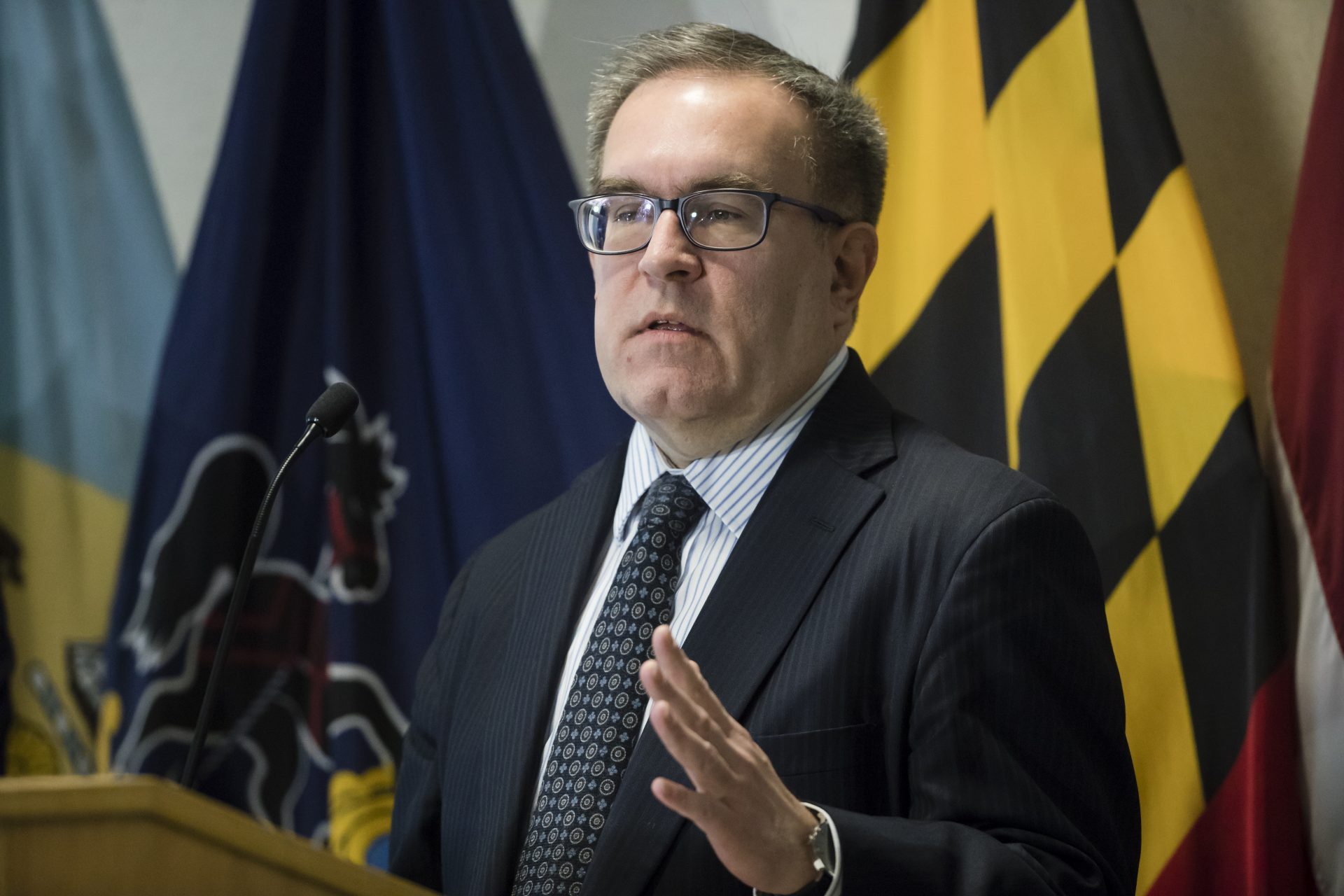
FILE PHOTO: The Horsham Air Guard Station in Bucks County, Pa.
Jon Hurdle / StateImpact Pennsylvania


FILE PHOTO: The Horsham Air Guard Station in Bucks County, Pa.
Jon Hurdle / StateImpact Pennsylvania

Jon Hurdle / StateImpact Pennsylvania
FILE PHOTO: The Horsham Air Guard Station in Bucks County, Pa.

Acting Environmental Protection Agency Administrator Andrew Wheeler speaks during a news conference in Philadelphia, Thursday, Feb. 14, 2019. (AP Photo/Matt Rourke)
The U.S. Environmental Protection Agency said Thursday it will this year begin the process of setting maximum contaminant limits for PFOA and PFOS, two toxic chemicals that are linked to cancer and other illnesses and are widespread in drinking water and soil.
The agency released a long-awaited Action Plan on how to manage contamination by the two chemicals and others in the PFAS family.
“EPA is moving forward with a maximum contaminant level process outlined in the Safe Drinking Water Act for PFOA and PFOS, two of the most well known and prevalent PFAS chemicals,” said the EPA’s Assistant Administrator for Water, Dave Ross.
“By the end of this year, EPA will propose a regulatory determination, which is the next step under the Safe Drinking Water Act, for establishing an MCL,” Ross said. “Our intent is to establish a MCL for PFOA and PFOS.”
But critics said the EPA’s plan represents another deferral of federal action to curb the chemicals.
“Essentially, EPA announced they are going to study further whether or not they will consider setting federal MCLs, a ‘plan’ that lacks any sense of urgency and offers no timely relief to people exposed to these highly toxic compounds in their water,” said Delaware Riverkeeper Network, a Pennsylvania-based environmental group that advocates for stricter limits on the chemicals.
DRN said there is no reason for the EPA not to act immediately to set MCLs given voluminous scientific evidence of PFAS’ risks to public health. “Decades have passed since EPA began looking at these contaminants, which begs the question why they need more time to decide on MCLs,” it said.
EPA denied its plan represents another delay in regulating the chemicals. It intends to set MCLs for the two chemicals through a legally required regulatory process that includes public participation, said spokesperson John Konkus, in a statement. “This is not a delay,” he said.
But officials in New Jersey, which has set some of the toughest limits on PFAS chemicals, said the EPA’s plan was “disappointing” because it won’t be setting federal standards any time soon.
“The Trump Administration is leaving millions of Americans exposed to harmful chemicals for too long by choosing a drawn-out process that will delay establishing a federal maximum contaminant level for PFAS,” the New Jersey Department of Environmental Protection said in a statement.
Last September, New Jersey set the nation’s first MCL on another PFAS chemical, PFNA, and is expected to propose its own limits on PFOA and PFOS this spring.
In the Philadelphia region, PFOA and PFOS contamination has become a big issue in Montgomery and Bucks counties, in areas around two former military facilities. Residents in Horsham, Warrington, and Warminster have found out their water was contaminated. The chemicals are believed to have come from firefighting foams used at the military sites.
Mark Cuker is a member of the Buxmont Coalition for Safer Water and an environmental attorney. Cuker says he wants an MCL set for “non-detect” — meaning no level of them would be considered safe.
Currently, the EPA has an advisory level of 70 parts per trillion, while states like New Jersey have moved to set much more stringent levels.
“There’s just no reason why this couldn’t be done by now,” said Cuker. “So here’s an analogy, you’re drowning, life guard says I’m coming. You’re now going down for the third time. Lifeguard is still sitting on the beach saying I’m coming.”
Hope Grosse is a founder of BuxMont Citizens for Clean Water. Grosse got cancer at the age of 25, and says her and her family’s health problems are linked to PFAS water contamination from a nearby military base.
“This action plan is disgrace and unacceptable, said Grosse. “We will not sit around and wait.”
Environmental Working Group, a national advocate for curbing PFAS, called the EPA’s plan “a recipe for more contamination.”
EWG said the plan would not stop the introduction of new PFAS chemicals, clean up drinking water supplies, or alert the public to PFAS pollution.
“It’s shameful that the EPA has taken two decades to produce a plan that allows increased exposure to compounds whose makers have used the American people as guinea pigs and, with the EPA’s complicity, covered it up,” said Scott Faber, EWG’s senior vice president for government affairs.
EPA Acting Administrator Andrew Wheeler, at a news conference in Philadelphia, said the plan involved a “historic” coordination of the agency’s offices.
“It took groundbreaking efforts to develop this plan,” Wheeler said. “This is the first time we have utilized all of our program offices to deal with an emerging chemical of concern.”
At a separate briefing, Ross said the decision to begin PFAS regulation was contrary to a recent press report that the EPA had decided not to set national standards for the chemicals.
As part of its plan, EPA has also begun the process of listing PFOA and PFOS as hazardous substances under the Superfund law. That will help communities deal with existing contamination and recover costs from responsible parties.
Ross said EPA will also publish recommendations “very soon” on cleaning up the two chemicals in groundwater, an important source of drinking water for many communities. Ross said the EPA is also looking at whether to regulate other chemicals in the PFAS family.
The plan will include expanded monitoring for PFAS and will add the chemicals to its Unregulated Contaminant Monitoring Program. Ross said the agency’s latest testing showed that about 1 percent of public water systems had at least one sample with PFOA and PFOS concentrations greater than 70 parts per trillion, the agency’s current health advisory limit for the chemicals.
He said EPA will also step up its research into the human health and ecological effects of PFAS, will look at contamination pathways and the costs of curbing the substances, with special attention to emerging replacements for PFAS chemicals, notably GenX.
“Our goal is to close the gap on the science as quickly as possible,” Ross said.
Ross said the agency will also develop a “communication toolbox” on PFAS that state and local governments can use to communicate with the public on responding to the contamination.
“We owe it to the American public to be able to explain in very simple and easy to understand terms what are the risks that they face in their daily lives,” he said. “We are stepping up to provide the leadership that the public needs and deserves.”
Critics have frequently accused the EPA of failing to take a leadership role in curbing PFAS. Some state officials have called on the agency to set national standards for the chemicals, to avoid what they call a “patchwork” of state regulations.
U.S. Sen. Tom Carper (D-Del.) called the plan “insufficiently protective” and accused the EPA of lacking urgency on PFAS protection. He noted that former EPA Administrator Scott Pruitt had committed to publishing a national management plan on the chemicals almost a year ago.
“It has taken the EPA nearly a year just to kick the can even further down the road,” Carper said.
Pennsylvania State Sen. Maria Collett (D-Bucks and Montgomery Counties) welcomed the EPA’s move toward setting health limits on the chemical but said that, given uncertainties over when any regulation would be implemented, she would continue to campaign for her two bills to set MCLs for some of the chemicals, and list them as hazardous substances in Pennsylvania.
StateImpact Pennsylvania is a collaboration among WITF, WHYY, and the Allegheny Front. Reporters Reid Frazier, Rachel McDevitt and Susan Phillips cover the commonwealth’s energy economy. Read their reports on this site, and hear them on public radio stations across Pennsylvania.
(listed by story count)
StateImpact Pennsylvania is a collaboration among WITF, WHYY, and the Allegheny Front. Reporters Reid Frazier, Rachel McDevitt and Susan Phillips cover the commonwealth’s energy economy. Read their reports on this site, and hear them on public radio stations across Pennsylvania.
Climate Solutions, a collaboration of news organizations, educational institutions and a theater company, uses engagement, education and storytelling to help central Pennsylvanians toward climate change literacy, resilience and adaptation. Our work will amplify how people are finding solutions to the challenges presented by a warming world.